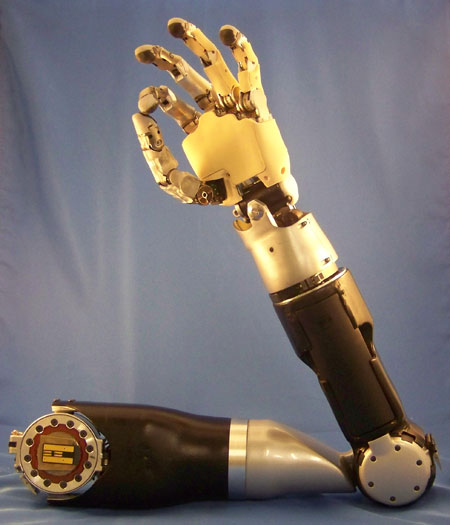Prosthetic Limbs
Prosthetic limbs (also known as artificial limbs) are a type of prosthesis which replace the extremities of the body, namely prosthetic arms, feet, legs, fingers and hands. Thus it helps the amputee to perform normal everyday tasks more easily, and in the process become more independent.
Prosthetic limbs can be either static or dynamic. Static prostheses are simple extensions (like peg legs) with which the patient does not have any sense of feeling. These normally end, for example, in hooks instead of hands. Dynamic prostheses use electronics to connect to the nervous system of the body (which uses electrical signals – myoelectricity). In the rest of this site, we will be looking at the types of prosthetic limbs, conventional technology used and new technology coming through.
Early Artificial Limbs
The world’s oldest known prosthetic limb was found in 2000, in a Cairo tomb, where an artificial toe was found on a female mummy, dating back to the period between 1069BC and 664BC. This means that prosthetic history goes all the way back to the 5th Egyptian Dynasty. Another prosthetic limb, this time discovered in a grave in Capua, Italy c.1910, dates back to 300 BC. In the 15th and 16th centuries, artificial limbs were crafted out of iron for soldiers and knights who lost their hands or arms, as a way to hide their disabilities.
Precursors to Modern Prosthetic Limbs
A pioneer in prosthetic limbs was French surgeon Ambroise Pare who in the 16th century, after introducing amputations as a life-saving procedure, started to produce limbs scientifically. His first design was an iron prosthetic leg with an articulated knee joint.
Wars like the Napoleonic Wars and the American Civil War in the 19th century made the use of prosthetic legs and prosthetic hands more frequent, due the high amount of amputees among injured soldiers. This led to the first Civil War amputee, J.E. Hanger, to develop a limb out of whittled barrel staves and also to found an orthotics company which is still in business today.
The same thing was done by Albert Winkley in the late 1800s, who after losing a foot in a farming accident, invented a slip socket to reduce the friction between the limb’s residual stump and the prosthetic device. He then started the Winkley Artificial Limb Company to market the socket to Civil War amputees. In 1863, Dubois L Parmelee of New York fastened a limb to a body socket using atmospheric pressure. In 1898, Dr. Vanghetti invented an artificial limb that could move through muscle contraction. The discovery of anaesthetic and more government funding after the Second World War have helped in the technological advances of prosthesis.
Modern Prosthetic Limbs
Computers and microchips are being used nowadays in order to create a much more natural feel to prostheses. Plastics and foams are the main materials, making artificial limbs lighter and allowing for modelling to match the body’s shape and skin colour.
But perhaps the most famous prosthetic limb to date is one of the simplest designs. Called the Cheetah (due to the resemblance to the wild cat’s hind legs), it was invented in 1976 by Van Philips so that he could participate in sports. It incorporates carbon fibre as material, and uses a wide J-shaped blade which, when the weight of the athlete is applied by landing on the heel, turns the force used into energy, allowing the runner to spring forward.


